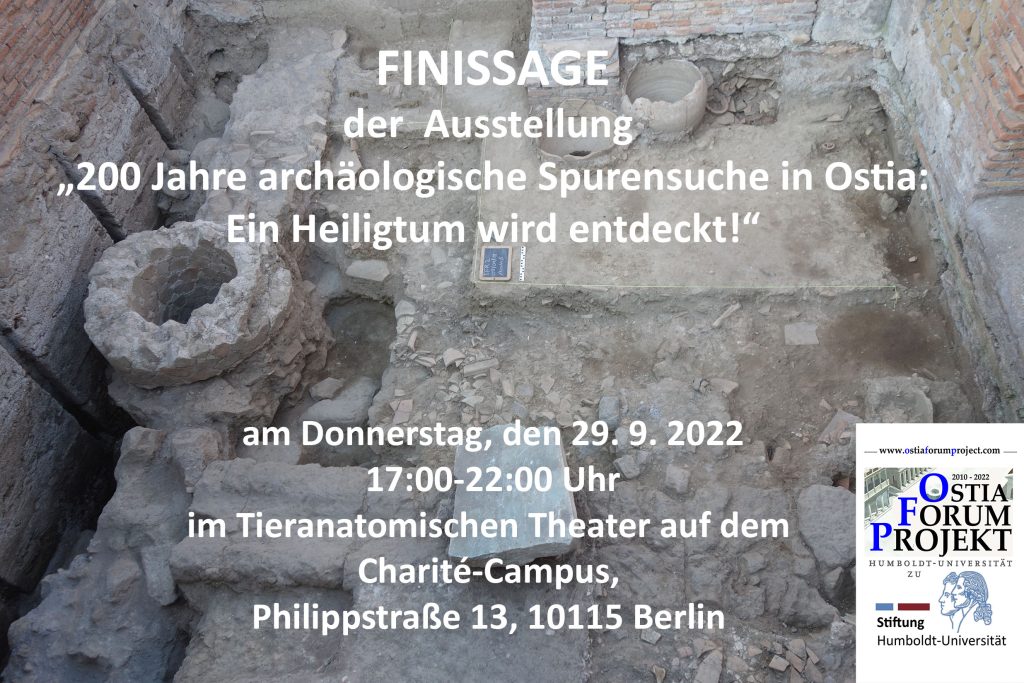Interview with Ph.d. student Sophie Menge
Ph.D. student Sophie Menge has been interviewed by the Stiftung Humboldt-Universität zu Berlin about the Humboldt-Universität zu Berlin.
The article is in German.
Ph.D. student Sophie Menge has been interviewed by the Stiftung Humboldt-Universität zu Berlin about the Humboldt-Universität zu Berlin.
The article is in German.
For the eight time, the École Francaise de Rome will host the Ostian seminar. The Ostia Forum Project is represented by three of its members. Prof. Dr. Axel Gering and ph.d. candidate Sophie Menge will be presenting the newest research on the sanctuary discovered in rooms TFR. Ph.d. candidate Daniel Damgaard will be presenting his newest research on the first Forum and its Republican phases.
The seminar will take place between March 21-23 2024. For more on the seminar, see the programme below.
From September 2 until October 13 2024, the annual excavation campaign will take place in the heart of Ostia. Once again, the focal point is the further examination of a hitherto unknown sanctuary. In that regard, the Ostia Forum Project is looking for eight participants, who can partake for the entirety of the campaign. All costs will be covered by the project.
For more information, see the document below (in German).
Once again, the Stiftung Humboldt-Universität zu Berlin finances scholarships in the Ostia Forum Project. This time it is a one 1-year scholarship (300€ / month) commencing April 1 2024. To be considered for the positions, you must be a bachelor or master student in Classical Archaeology and be present at the university.
If you are interested in Ostia and in getting to know that place more, then apply. The deadline is January 15, 2024
The Ostia Forum Project will be presenting in the international colloquium Urbs in transitum: innovazione e tradizione tra Roma e Ostia nel III secolo organised by Istituto Storico Austriaco, Academia Belgica and Parco archeologico di Ostia Antica. The colloquium will be taking place between October 4 and October 7 2023 in both Rome and Ostia.
The project is represented by the director, Prof. Dr. Axel Gering, and ph.d. student Sophie Menge. Their presentation is titled From sanctuary to shops. The transformation of the TFR-area northeast of the Forum from the 2nnd to the 3rd century AD.
Ph.D. candidate Daniel Damgaard is going to present his newest and final research regarding the Forum of Ostia in its diachronic perspective.
The venue is Friedrichstrasse 39, 79098 Freiburg i. Br. It is organised by Institut für Archäologische Wissenschaften – Abteilung Klassische Archäologie. The presentation begins at 18:00 c.t. in room HS 1015 (KG I).
For the semester programme, see below
The Stiftung Humboldt-Universität zu Berlin finances five one-year scholarships (300€ / month). To be considered for the positions, you must be a bachelor or master student and be present at the university from April 2023 to March 2024 – the two following semesters.
You will attend the lecture Archäometrie in the sommer semester, which is being conducted by Prof. Dr. Axel Gering, and you are to attend the excavation in September-October 2023 in the Forum of Ostia. There will also be some ad hoc tasks along the way.
Thus, if you are interested in Ostia and are interested in getting to know that place more, then apply. The deadline is January 30, 2023
Dear all,
The Ostia Forum Project would like to wish everybody a very merry Christmas, and would like to thank all corporation partners for a very interesting and fruitful year!
We look forward to yet another fulfilling year in 2023.
The exhibition “A 200 year-long Quest for Traces in Ostia: The Discovery of a Sanctuary” is coming to an end. The last day of the exhibition is Friday September 30. In that regard, the Ostia Forum Project would like to invite everybody to a finissage Thursday September 29, 17:00 – 22:00.
As with the opening of the exhibition, the finissage will take place at the Tieranatomischen Theater in Berlin, Philippstrasse 13, 10115 Berlin.
We hope to see as many as possible. Drinks and snacks will be served.
